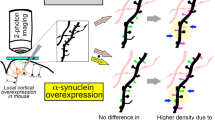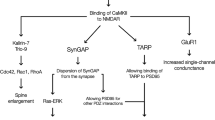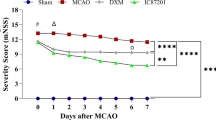Abstract
Aquaporin-4 (AQP4), the most abundant aquaporin in the brain, is polarized at the glial end-feet facing peri-synaptic areas. AQP4 has been hypothesized to modulate water and potassium fluxes associated with neuronal activity in pathophysiological states. However, the role of AQP4 in astroglial signaling under physiological conditions is unclear. Herein, AQP4 knockout mice and wild-type littermates were tested in the Morris water maze (MWM), which allows for investigating the role of AQP4 in long-term learning and memory. Compared with wild-type mice, AQP4 knockout mice appeared actually to find the platform more easy, but to forget more quickly, in the MWM, indicating that AQP4 knockout mice exhibited impaired memory consolidation in MWM. Moreover, the deficits of memory consolidations were associated with defects in theta-burst stimulation-induced long-term potentiation both in vivo and in vitro. Furthermore, AQP4 knockout mice were accompanied by a decrease in the incorporation of adult-generated granule cells into spatial memory networks. Taken together, our findings indicate that AQP4 plays a modulatory role in memory consolidation. Targeting glial AQP4 may be a new therapeutic strategy for neurodegenerative disorders and related memory impairment.






Similar content being viewed by others
References
Cavazzin C, Ferrari D, Facchetti F, Russignan A, Vescovi AL, La Porta CA, Gritti A (2006) Unique expression and localization of aquaporin-4 and aquaporin-9 in murine and human neural stem cells and in their glial progeny. Glia 53(2):167–181
Chi Y, Fan Y, He L, Liu W, Wen X, Zhou S, Wang X, Zhang C, Kong H, Sonoda L, Tripathi P, Li CJ, Yu MS, Su C, Hu G (2011) Novel role of aquaporin-4 in CD4(+) CD25(+) T regulatory cell development and severity of Parkinson’s disease. Aging cell 10(3):368–382
Christensen N, D'Souza M, Zhu X, Frisina RD (2009) Age-related hearing loss: aquaporin 4 gene expression changes in the mouse cochlea and auditory midbrain. Brain Res 1253:27–34
Deng W, Aimone JB, Gage FH (2010) New neurons and new memories: how does adult hippocampal neurogenesis affect learning and memory? Nat Rev Neurosci 11(5):339–350
Dickinson-Anson H (2003) Acetylcholine-secreting cells improve age-induced memory deficits. Mol Ther 8(1):51–61
Ding JH, Sha LL, Chang J, Zhou XQ, Fan Y, Hu G (2007) Alterations of striatal neurotransmitter release in aquaporin-4 deficient mice: An in vivo microdialysis study. Neurosci Lett 422(3):175–180
Dupret D, Fabre A, Dobrossy MD, Panatier A, Rodriguez JJ, Lamarque S, Lemaire V, Oliet SH, Piazza PV, Abrous DN (2007) Spatial learning depends on both the addition and removal of new hippocampal neurons. PLoS Biol 5(8):e214
Fan Y, Zhang J, Sun XL, Gao L, Zeng XN, Ding JH, Cao C, Niu L, Hu G (2005) Sex- and region-specific alterations of basal amino acid and monoamine metabolism in the brain of aquaporin-4 knockout mice. J Neurosci Res 82(4):458–464
Fan Y, Kong H, Shi X, Sun X, Ding J, Wu J, Hu G (2008) Hypersensitivity of aquaporin 4-deficient mice to 1-methyl-4-phenyl-1,2,3,6-tetrahydropyridine and astrocytic modulation. Neurobiol Aging 29(8):1226–1236
Fischer W, Bjorklund A, Chen K, Gage FH (1991) NGF improves spatial memory in aged rodents as a function of age. J Neurosci 11(7):1889–1906
Jahanshahi M, Sadeghi Y, Hosseini A, Naghdi N, Marjani A (2008) The effect of spatial learning on the number of astrocytes in the CA3 subfield of the rat hippocampus. Singap Med J 49(5):388–391
Jedlicka P, Papadopoulos T, Deller T, Betz H, Schwarzacher SW (2009a) Increased network excitability and impaired induction of long-term potentiation in the dentate gyrus of collybistin-deficient mice in vivo. Mol Cell Neurosci 41(1):94–100
Jedlicka P, Schwarzacher SW, Winkels R, Kienzler F, Frotscher M, Bramham CR, Schultz C, Bas Orth C, Deller T (2009b) Impairment of in vivo theta-burst long-term potentiation and network excitability in the dentate gyrus of synaptopodin-deficient mice lacking the spine apparatus and the cisternal organelle. Hippocampus 19(2):130–140
Katagiri H, Tanaka K, Manabe T (2001) Requirement of appropriate glutamate concentrations in the synaptic cleft for hippocampal LTP induction. Eur J Neurosci 14(3):547–553
Kee N, Teixeira CM, Wang AH, Frankland PW (2007) Preferential incorporation of adult-generated granule cells into spatial memory networks in the dentate gyrus. Nat Neurosci 10(3):355–362
Kelsch W, Sim S, Lois C (2010) Watching synaptogenesis in the adult brain. Annu Rev Neurosci 33:131–149
Kitaura H, Tsujita M, Huber VJ, Kakita A, Shibuki K, Sakimura K, Kwee IL, Nakada T (2009) Activity-dependent glial swelling is impaired in aquaporin-4 knockout mice. Neurosci Res 64(2):208–212
Koehl M, Abrous DN (2011) A new chapter in the field of memory: adult hippocampal neurogenesis. Eur J Neurosci 33(6):1101–1114
Kong H, Fan Y, Xie J, Ding J, Sha L, Shi X, Sun X, Hu G (2008) AQP4 knockout impairs proliferation, migration and neuronal differentiation of adult neural stem cells. J Cell Sci 121(Pt 24):4029–4036
Kong H, Sha LL, Fan Y, Xiao M, Ding JH, Wu J, Hu G (2009) Requirement of AQP4 for antidepressive efficiency of fluoxetine: implication in adult hippocampal neurogenesis. Neuropsychopharmacology 34(5):1263–1276
Kuppers E, Gleiser C, Brito V, Wachter B, Pauly T, Hirt B, Grissmer S (2008) AQP4 expression in striatal primary cultures is regulated by dopamine—implications for proliferation of astrocytes. Eur J Neurosci 28(11):2173–2182
La Porta CA, Gena P, Gritti A, Fascio U, Svelto M, Calamita G (2006) Adult murine CNS stem cells express aquaporin channels. Biol Cell 98(2):89–94
Liu L, Su Y, Yang W, Xiao M, Gao J, Hu G (2010) Disruption of neuronal–glial–vascular units in the hippocampus of ovariectomized mice injected with d-galactose. Neuroscience 169(2):596–608
Lonergan ME, Gafford GM, Jarome TJ, Helmstetter FJ (2010) Time-dependent expression of Arc and zif268 after acquisition of fear conditioning. Neural Plast 2010:139891
Mora F, Segovia G, del Arco A (2007) Aging, plasticity and environmental enrichment: structural changes and neurotransmitter dynamics in several areas of the brain. Brain Res Rev 55(1):78–88
Nicchia GP, Srinivas M, Li W, Brosnan CF, Frigeri A, Spray DC (2005) New possible roles for aquaporin-4 in astrocytes: cell cytoskeleton and functional relationship with connexin43. FASEB J 19(12):1674–1676
Palop JJ, Chin J, Mucke L (2006) A network dysfunction perspective on neurodegenerative diseases. Nature 443 (7113):768–773
Pannasch U, Vargova L, Reingruber J, Ezan P, Holcman D, Giaume C, Sykova E, Rouach N (2011) Astroglial networks scale synaptic activity and plasticity. Proc Natl Acad Sci USA 108(20):8467–8472
Papadopoulos MC, Saadoun S, Verkman AS (2008) Aquaporins and cell migration. Pflugers Arch 456(4):693–700
Park DC, Reuter-Lorenz P (2009) The adaptive brain: aging and neurocognitive scaffolding. Annu Rev Psychol 60:173–196
Patil SS, Sunyer B, Hoger H, Lubec G (2008) Apodemus sylvaticus (LOXT) is a suitable mouse strain for testing spatial memory retention in the Morris water maze. Neurobiol Learn Mem 89(4):552–559
Patil SS, Sunyer B, Hoger H, Lubec G (2009) Evaluation of spatial memory of C57BL/6J and CD1 mice in the Barnes maze, the Multiple T-maze and in the Morris water maze. Behav Brain Res 198(1):58–68
Peebles CL, Yoo J, Thwin MT, Palop JJ, Noebels JL, Finkbeiner S (2010) Arc regulates spine morphology and maintains network stability in vivo. Proc Natl Acad Sci USA 107(42):18173–18178
Rodriguez JJ, Davies HA, Errington ML, Verkhratsky A, Bliss TV, Stewart MG (2008) ARG3. 1/ARC expression in hippocampal dentate gyrus astrocytes: ultrastructural evidence and co-localization with glial fibrillary acidic protein. J Cell Mol Med 12(2):671–678
Skucas VA, Mathews IB, Yang J, Cheng Q, Treister A, Duffy AM, Verkman AS, Hempstead BL, Wood MA, Binder DK, Scharfman HE (2011) Impairment of select forms of spatial memory and neurotrophin-dependent synaptic plasticity by deletion of glial aquaporin-4. J Neurosci 31(17):6392–6397
Strohschein S, Huttmann K, Gabriel S, Binder DK, Heinemann U, Steinhauser C (2011) Impact of aquaporin-4 channels on K(+) buffering and gap junction coupling in the hippocampus. Glia 59(6):973–980
Tanaka K (2000) Functions of glutamate transporters in the brain. Neurosci Res 37(1):15–19
Tsvetkov E, Shin RM, Bolshakov VY (2004) Glutamate uptake determines pathway specificity of long-term potentiation in the neural circuitry of fear conditioning. Neuron 41(1):139–151
Tzingounis AV, Nicoll RA (2006) Arc/Arg3.1: linking gene expression to synaptic plasticity and memory. Neuron 52(3):403–407
Wolfer DP, Lipp HP (2000) Dissecting the behaviour of transgenic mice: is it the mutation, the genetic background, or the environment? Exp Physiol 85(6):627–634
Yuan S, Zhang W, Ding J, Yao J, Jiang Q, Hu G (2009) Increased sensitivity to retinal light damage in aquaporin-4 knockout mice. Exp Eye Res 89(1):119–122
Zador Z, Stiver S, Wang V, Manley GT (2009) Role of aquaporin-4 in cerebral edema and stroke. Handb Exp Pharmacol 190:159–170
Zeng XN, Sun XL, Gao L, Fan Y, Ding JH, Hu G (2007) Aquaporin-4 deficiency down-regulates glutamate uptake and GLT-1 expression in astrocytes. Mol Cell Neurosci 34(1):34–39
Acknowledgments
This study was supported by the grants from the National Key Basic Research Program of China (No. 2011CB504103), the National Natural Science Foundation of China (No. 81030060, No. 30973517 and No. 81173032,), and the key project of Natural Science Foundation of the Higher Education Institutions of Jiangsu Province (No. 11KJA310003).
Conflict of interest
The authors declare that they have no conflict of interest.
Author information
Authors and Affiliations
Corresponding author
Rights and permissions
About this article
Cite this article
Fan, Y., Liu, M., Wu, X. et al. Aquaporin-4 promotes memory consolidation in Morris water maze. Brain Struct Funct 218, 39–50 (2013). https://doi.org/10.1007/s00429-011-0373-2
Received:
Accepted:
Published:
Issue Date:
DOI: https://doi.org/10.1007/s00429-011-0373-2




